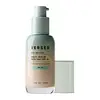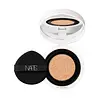Versed Skin Solution Multi-Serum Skin Tint Foundation SPF 40 Versus NARS Cosmetics Light Reflecting Serum Cushion Foundation SPF 50+
What's inside
What's inside
 Key Ingredients
Key Ingredients

 Benefits
Benefits

 Concerns
Concerns

 Ingredients Side-by-side
Ingredients Side-by-side

Zinc Oxide 13.1%
Cosmetic ColorantWater
Skin ConditioningCoco-Caprylate/Caprate
EmollientC9-12 Alkane
SolventPropanediol
SolventButyloctyl Salicylate
Skin ConditioningGlycerin
HumectantPolyglyceryl-2 Dipolyhydroxystearate
Skin ConditioningC15-19 Alkane
SolventPolyglyceryl-4 Isostearate
EmulsifyingPolyhydroxystearic Acid
EmulsifyingMagnesium Sulfate
Tocopheryl Acetate
AntioxidantTerminalia Ferdinandiana Fruit Extract
AntioxidantJojoba Esters
EmollientHydrolyzed Sodium Hyaluronate
Skin ConditioningHydroxyacetophenone
AntioxidantTriheptanoin
Skin ConditioningTriethyl Citrate
MaskingPolyglyceryl-3 Polyricinoleate
EmulsifyingDilinoleic Acid/Butanediol Copolymer
Castor Oil/Ipdi Copolymer
Sorbitan Isostearate
EmulsifyingMica
Cosmetic ColorantDisteardimonium Hectorite
StabilisingQuaternium-90 Bentonite
Phenoxyethanol
PreservativeEthylhexylglycerin
Skin ConditioningTitanium Dioxide
Cosmetic ColorantIron Oxides
Zinc Oxide 13.1%, Water, Coco-Caprylate/Caprate, C9-12 Alkane, Propanediol, Butyloctyl Salicylate, Glycerin, Polyglyceryl-2 Dipolyhydroxystearate, C15-19 Alkane, Polyglyceryl-4 Isostearate, Polyhydroxystearic Acid, Magnesium Sulfate, Tocopheryl Acetate, Terminalia Ferdinandiana Fruit Extract, Jojoba Esters, Hydrolyzed Sodium Hyaluronate, Hydroxyacetophenone, Triheptanoin, Triethyl Citrate, Polyglyceryl-3 Polyricinoleate, Dilinoleic Acid/Butanediol Copolymer, Castor Oil/Ipdi Copolymer, Sorbitan Isostearate, Mica, Disteardimonium Hectorite, Quaternium-90 Bentonite, Phenoxyethanol, Ethylhexylglycerin, Titanium Dioxide, Iron Oxides
Water
Skin ConditioningTitanium Dioxide
Cosmetic ColorantDecyl Cocoate
EmollientPropanediol
SolventPolyglyceryl-6 Polyricinoleate
EmulsifyingGlycerin
HumectantC15-19 Alkane
SolventPentylene Glycol
Skin ConditioningSynthetic Fluorphlogopite
Polyglyceryl-4 Oleate
EmulsifyingIsoamyl Laurate
EmollientCetyl Ethylhexanoate
EmollientDioctyldodecyl Dimer Dilinoleate
EmollientGlyceryl Oleate
EmollientSorbitan Isostearate
EmulsifyingButyloctyl Salicylate
Skin ConditioningPolyglyceryl-10 Pentaisostearate
EmollientCamellia Japonica Flower Extract
EmollientPrunus Domestica Fruit Extract
MoisturisingCitrus Junos Peel Extract
Skin ConditioningMoringa Oleifera Seed Extract
Skin ConditioningTerminalia Ferdinandiana Fruit Extract
AntioxidantTheobroma Cacao Seed Extract
AntioxidantStearic Acid
CleansingAlumina
AbrasiveAluminum Hydroxide
EmollientSodium Lauroyl Glutamate
Lysine
Skin ConditioningMagnesium Chloride
Hydrogenated Rapeseed Alcohol
EmollientButylene Glycol
Humectant1,2-Hexanediol
Skin ConditioningEthylhexylglycerin
Skin ConditioningCoco-Caprylate/Caprate
EmollientTriheptanoin
Skin ConditioningC9-12 Alkane
SolventDilinoleic Acid/Butanediol Copolymer
Castor Oil/Ipdi Copolymer
Lactobacillus Ferment Lysate
Skin ConditioningDisodium Phosphate
BufferingCitric Acid
BufferingMagnesium Sulfate
Stearalkonium Hectorite
Gel FormingTrisodium Ethylenediamine Disuccinate
Parfum
MaskingBenzyl Salicylate
PerfumingCitronellol
PerfumingGeraniol
PerfumingLimonene
PerfumingCI 77491
Cosmetic ColorantCI 77492
Cosmetic ColorantCI 77499
Cosmetic ColorantCI 77891
Cosmetic ColorantWater, Titanium Dioxide, Decyl Cocoate, Propanediol, Polyglyceryl-6 Polyricinoleate, Glycerin, C15-19 Alkane, Pentylene Glycol, Synthetic Fluorphlogopite, Polyglyceryl-4 Oleate, Isoamyl Laurate, Cetyl Ethylhexanoate, Dioctyldodecyl Dimer Dilinoleate, Glyceryl Oleate, Sorbitan Isostearate, Butyloctyl Salicylate, Polyglyceryl-10 Pentaisostearate, Camellia Japonica Flower Extract, Prunus Domestica Fruit Extract, Citrus Junos Peel Extract, Moringa Oleifera Seed Extract, Terminalia Ferdinandiana Fruit Extract, Theobroma Cacao Seed Extract, Stearic Acid, Alumina, Aluminum Hydroxide, Sodium Lauroyl Glutamate, Lysine, Magnesium Chloride, Hydrogenated Rapeseed Alcohol, Butylene Glycol, 1,2-Hexanediol, Ethylhexylglycerin, Coco-Caprylate/Caprate, Triheptanoin, C9-12 Alkane, Dilinoleic Acid/Butanediol Copolymer, Castor Oil/Ipdi Copolymer, Lactobacillus Ferment Lysate, Disodium Phosphate, Citric Acid, Magnesium Sulfate, Stearalkonium Hectorite, Trisodium Ethylenediamine Disuccinate, Parfum, Benzyl Salicylate, Citronellol, Geraniol, Limonene, CI 77491, CI 77492, CI 77499, CI 77891
Ingredients Explained
These ingredients are found in both products.
Ingredients higher up in an ingredient list are typically present in a larger amount.
Butyloctyl Salicylate is a chemical UV filter structurally similar to octisalate. It is a photostabilizer, SPF booster, emollient and solvent. This ingredient helps evenly spread out ingredients.
According to a manufacturer, it is suitable for pairing with micro Titanium Dioxide, Zinc Oxide, and pigments.
Photostabilizers help stabilize UV-filters and prevents them from degrading quickly.
Learn more about Butyloctyl SalicylateC15-19 alkane is a mixture of alkanes. Alkanes are hydrocarbons with carbon atoms held together by single bonds.
It is a synthetically created solvent and emollient often used to replace silicones or mineral oil. As an emollient, C15-19 Alkane helps soften and soothe the skin. Emollients create a barrier to trap moisture inside.
C15-19 Alkane is often used with mineral UV filters such as titanium dioxidide and zinc oxide. It helps these UV filter ingredients be more spreadable.
C15-19 Alkane is biodegradable.
Learn more about C15-19 AlkaneC9-12 Alkane is synethically created using alkanes, or paraffins. It is added to products as a solvent. This means its main purpose is to help dissolve ingredients and create even texture.
Castor Oil/Ipdi Copolymer is an oil and isn't fungal acne safe.
Coco-Caprylate/Caprate is created from fatty coconut alcohol, caprylic acid, and capric acid.
It is a lightweight emollient. Emollients create a thin barrier on the skin to trap moisture in. This helps keep your skin hydrated and soft.
Once applied, Coco-Caprylate/Caprate is absorbed quickly and leaves a silky feel.
Coco-Caprylate/Caprate may not be fungal acne safe.
Learn more about Coco-Caprylate/CaprateWe don't have a description for Dilinoleic Acid/Butanediol Copolymer yet.
Ethylhexylglycerin (we can't pronounce this either) is commonly used as a preservative and skin softener. It is derived from glyceryl.
You might see Ethylhexylglycerin often paired with other preservatives such as phenoxyethanol. Ethylhexylglycerin has been found to increase the effectiveness of these other preservatives.
Glycerin is already naturally found in your skin. It helps moisturize and protect your skin.
A study from 2016 found glycerin to be more effective as a humectant than AHAs and hyaluronic acid.
As a humectant, it helps the skin stay hydrated by pulling moisture to your skin. The low molecular weight of glycerin allows it to pull moisture into the deeper layers of your skin.
Hydrated skin improves your skin barrier; Your skin barrier helps protect against irritants and bacteria.
Glycerin has also been found to have antimicrobial and antiviral properties. Due to these properties, glycerin is often used in wound and burn treatments.
In cosmetics, glycerin is usually derived from plants such as soybean or palm. However, it can also be sourced from animals, such as tallow or animal fat.
This ingredient is organic, colorless, odorless, and non-toxic.
Glycerin is the name for this ingredient in American English. British English uses Glycerol/Glycerine.
Learn more about GlycerinMagnesium Sulfate is a salt. More specifically, it is an epsom salt, or the bath salt used to help relieve muscle aches.
Despite having ‘sulfate’ in the name, it isn’t a surfactant or cleansing agent like sodium lauryl sulfate. Unlike those sulfates, magnesium sulfate doesn’t have the same cleansing or foaming properties (it's simply a type of salt).
In cosmetics, Magnesium Sulfate is used to thicken a product or help dilute other solids. It is a non-reactive and non-irritating ingredient.
One study shows magnesium deficiency may lead to inflammation of the skin. Applying magnesium topically may help reduce inflammation.
You can find this ingredient in sea water or mineral deposits.
Learn more about Magnesium SulfatePropanediol is an all-star ingredient. It softens, hydrates, and smooths the skin.
It’s often used to:
Propanediol is not likely to cause sensitivity and considered safe to use. It is derived from corn or petroleum with a clear color and no scent.
Learn more about PropanediolSorbitan Isostearate is an emulsifer and cleaning agent. It is created from isostearic acid and sorbitol.
As an emulsifier, Sorbitan Isostearate prevents oils and water from separating.
Due to its isostearic acid base, it may not be safe for Malassezia or fungal acne.
Learn more about Sorbitan IsostearateTerminalia Ferdinandiana Fruit Extract is from the Kakadu plum. The Kakadu plum is native to northern Australia. The Kakadu plum holds the record for having the highest amount of natural vitamin C.
This ingredient is an antioxidant. Antioxidants help fight free-radical molecules. Free-radical molecules are capable of damaging our cells and other genetic material. Antioxidants help stabilize free-radicals and thus may reduce the signs of aging.
The high vitamin C content of Kakadu plum also helps lighten skin. Vitamin C has been shown to block the process of skin darkening that leads to hyperpigmentation.
Kakadu plums have been used by indigenous cultures as medicine to help treat colds and as an antiseptic.
Learn more about Terminalia Ferdinandiana Fruit ExtractTitanium dioxide is a mineral UV filter widely used in sunscreens and cosmetics.
It is one of only two UV filters officially classified as “mineral” by regulatory agencies, the other being zinc oxide.
Titanium dioxide provides broad-spectrum protection mostly in the UVB and UVAII range, with some protection in the UVAI range.
While its UVA protection isn’t as strong as zinc oxide’s, the difference is minor.
A common myth is that mineral UV filters reflect UV light. However, modern research shows titanium dioxide absorbs UV radiation like chemical filters (~95% absorption & 5% reflection).
Thanks to its non-irritating nature, titanium dioxide is suitable for sensitive, acne-prone, or redness-prone skin. It is unlikely to cause "eye sting" like other sunscreen ingredients.
A major drawback of this ingredient is its white cast and thick texture. This is why mineral sunscreens often leave a white cast and are less cosmetically elegant than chemical/hybrid sunscreens.
To improve white cast and spreadability, micronized or nano-sized titanium dioxide is often used.
There are ongoing concerns surrounding nano-titanium oxide's impact on marine ecosystems.
There is no conclusive evidence that any form of titanium oxide (or any other sunscreen ingredients) will cause harm to marine ecosystems or coral reefs. The science is still developing but many consumers are keeping a close eye on this issue.
Please note, many destinations have reef-safety sunscreen rules. For instance, the U.S. Virgin Islands advises all visitors to use non-nano mineral sunscreens.
Nano mineral sunscreens once raised safety concerns about absorption into skin.
Extensive research has shown that they do not penetrate healthy or damaged skin; they remain safely on the surface and the top layer of dead skin (stratum corneum).
You'll likely find titanium dioxide bundled with alumina, silica, or dimethicone. These ingredients help make titanium dioxide highly photostable; this prevents it from interacting with other formula components under UV light.
Learn more about Titanium DioxideWe don't have a description for Triheptanoin yet.
Water. It's the most common cosmetic ingredient of all. You'll usually see it at the top of ingredient lists, meaning that it makes up the largest part of the product.
So why is it so popular? Water most often acts as a solvent - this means that it helps dissolve other ingredients into the formulation.
You'll also recognize water as that liquid we all need to stay alive. If you see this, drink a glass of water. Stay hydrated!
Learn more about Water